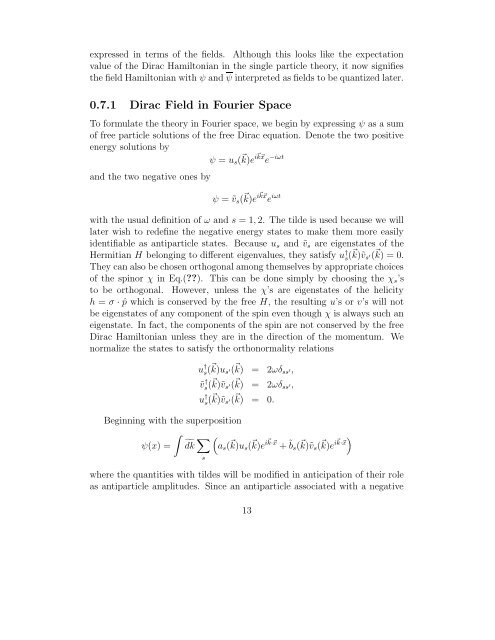0.1 Klein-Gordon Equation 0.2 Dirac Equation
0.1 Klein-Gordon Equation 0.2 Dirac Equation
0.1 Klein-Gordon Equation 0.2 Dirac Equation
Create successful ePaper yourself
Turn your PDF publications into a flip-book with our unique Google optimized e-Paper software.
expressed in terms of the fields. Although this looks like the expectation<br />
value of the <strong>Dirac</strong> Hamiltonian in the single particle theory, it now signifies<br />
the field Hamiltonian with ψ and ψ interpreted as fields to be quantized later.<br />
0.7.1 <strong>Dirac</strong> Field in Fourier Space<br />
To formulate the theory in Fourier space, we begin by expressing ψ as a sum<br />
of free particle solutions of the free <strong>Dirac</strong> equation. Denote the two positive<br />
energy solutions by<br />
ψ = u s ( ⃗ k)e i⃗ k⃗x e −iωt<br />
and the two negative ones by<br />
ψ = ṽ s ( ⃗ k)e i⃗ k⃗x e iωt<br />
with the usual definition of ω and s = 1, 2. The tilde is used because we will<br />
later wish to redefine the negative energy states to make them more easily<br />
identifiable as antiparticle states. Because u s and ṽ s are eigenstates of the<br />
Hermitian H belonging to different eigenvalues, they satisfy u † s (⃗ k)ṽ s ′( ⃗ k) = 0.<br />
They can also be chosen orthogonal among themselves by appropriate choices<br />
of the spinor χ in Eq.(??). This can be done simply by choosing the χ s ’s<br />
to be orthogonal. However, unless the χ’s are eigenstates of the helicity<br />
h = σ · ˆp which is conserved by the free H, the resulting u’s or v’s will not<br />
be eigenstates of any component of the spin even though χ is always such an<br />
eigenstate. In fact, the components of the spin are not conserved by the free<br />
<strong>Dirac</strong> Hamiltonian unless they are in the direction of the momentum. We<br />
normalize the states to satisfy the orthonormality relations<br />
u † s( ⃗ k)u s ′( ⃗ k) = 2ωδ ss ′,<br />
ṽ † s (⃗ k)ṽ s ′( ⃗ k) = 2ωδ ss ′,<br />
u † s (⃗ k)ṽ s ′( ⃗ k) = 0.<br />
Beginning with the superposition<br />
∫ (<br />
ψ(x) = a s ( ⃗ k)u s ( ⃗ k)e i⃗k·⃗x + ˜b s ( ⃗ k)ṽ s ( ⃗ )<br />
k)e i⃗ k·⃗x<br />
˜dk ∑ s<br />
where the quantities with tildes will be modified in anticipation of their role<br />
as antiparticle amplitudes. Since an antiparticle associated with a negative<br />
13
















